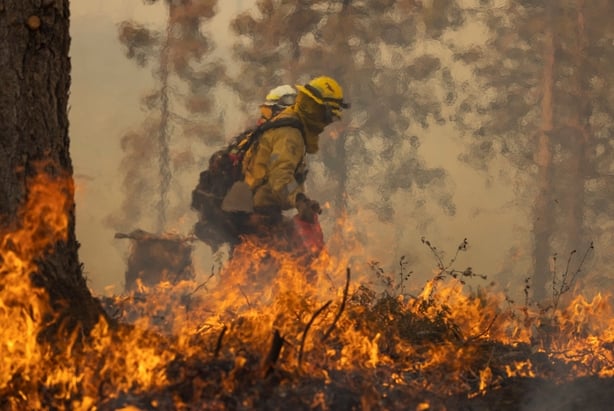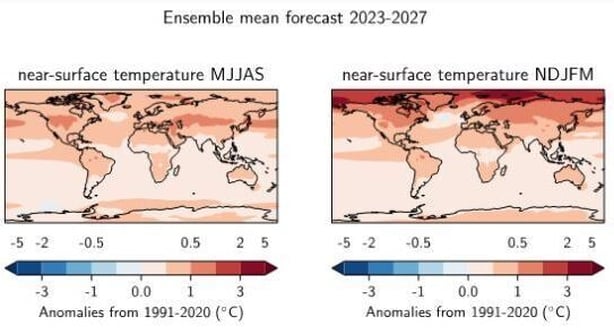The World Meteorological Organisation (WMO) has warned that a warming climatic event in the coming months, combined with human-induced climate change, will have far reaching repercussions for health, food security, water management and the environment.
The WMO said people need to be prepared and that rising temperatures are moving us further and further away from the climate we are used to.
This stark warning from the WMO is contained in a synthesis of temperature predictions for the next five years from its 145 member organisations, led on this occasion by the UK Met Office.
We need your consent to load this rte-player contentWe use rte-player to manage extra content that can set cookies on your device and collect data about your activity. Please review their details and accept them to load the content.Manage Preferences
It says that we can be practically certain that at least one of the next five years will be the warmest year on record, and that temperatures in the next five years will be warmer than the past five years.
What makes them so sure are very strong signs that, late this year, we are likely to enter a positive El Niño climatic event.
El Niño is the name given to a naturally occurring pattern of warming surface waters in the eastern tropical Pacific Ocean that drive up temperatures elsewhere in the world.

The report says that this, combined with the underlying global warming trends, will drive the average temperatures to between 1.1 and 1.8 degrees Celsius above pre-industrial levels for each of the next five years.
It says there is a 66% likelihood that global temperatures will exceed the key level of 1.5 degrees Celsius of warming in at least one of those years.

Read the report in full here
Latest climate change stories
Secretary General of the WMO Petteri Taalas said, however, that this would not, of itself, be a permanent or long-term exceedance of the key Paris 1.5 degrees Celsius global warming target, but that his organisation is sounding the alarm that we will breach that 1.5 degrees Celsius on a temporary basis with increasing frequency.
Climate science expert at the UK Met Office Dr Leon Hermanson said the continued rise in global mean temperatures is moving us further and further away from the climate we are used to.
Among the impacts, according to the report, is an increased chance of above average summer rainfall in Northern Europe for the next five years - a region that includes Ireland.
Another likely impact is that warming in the Arctic will be three times faster than the global average.
In addition, human-induced greenhouse gases are leading to more ocean heating and acidification, sea ice and glacier melt, sea level rise and more extreme weather events.
The report is being released ahead of the quadrennial World Meteorological Congress which starts next Monday and will discuss how to strengthen weather and climate services, including early warning systems to protect the most vulnerable people from increasingly extreme weather.
'More droughts, more heatwaves, more extreme flooding'
Eoin Moran, Director of Met Éireann and Ireland's permanent representative at the WMO, emphasised that this projection is a "temporary spike", not a "permanent state...that could happen over the next five years".
Speaking on RTÉ's Six One News, he added it is "very likely" that over the next five years the global maximum temperature record will be broken.
Mr Moran said it was a combination of natural occurrences and human behaviours that lead to the release of greenhouse gases.

He said there will be three times more warming in the Arctic than the average warming projected around the world.
Mr Moran said the trend in Ireland of rising temperatures is consistent with the global trend, adding that 2022 was the warmest year on record, and the 12th consecutive year that it was warmer than the year before.
"As climate change proceeds, as we continue to emit greenhouse gases into the atmosphere, we're going to be continuing to force this chaotic, dynamical system towards extremes," Mr Moran said.
"So, we will see more droughts, more heatwaves, more extreme flooding events, and the impacts on our supply systems, on agriculture, on migration, and the societal effects will become more evident, as we've seen in recent years."
He said technical solutions exist to reverse these trends, but that "we do not need to be operating within a fossil fuel-dependent economy".
"There are plans now, as we know, nationally and internationally, to adapt to climate change but also importantly to mitigate the emissions and to reduce them rapidly."

The main predictions in today's report are:
- The average global temperature in 2022 was about 1.15 degrees Celsius above the 1850-1900 average.
- The cooling influence of La Niña conditions over much of the past three years temporarily reined in the longer-term warming trend.
- The La Niña conditions ended in March 2023 and an El Niño is forecast to develop in the coming months. Typically, El Niño increases global temperatures in the year after it develops – in this case this would be 2024.
- The El Niño Southern Oscillation (ENSO) is predicted to most likely be positive in December to February 2023/24.
- The annual mean global near-surface temperature for each year between 2023 and 2027 is predicted to be between 1.1 degrees Celsius and 1.8 degrees Celsius higher than pre-industrial levels.
- There is a 98% chance of at least one in the next five years beating the temperature record set in 2016, when there was an exceptionally strong El Niño.
- The chance of the five-year mean for 2023-2027 being higher than the last five years is also 98%.
- There is 66% chance that annual global surface temperature will temporarily exceed 1.5°C above pre-industrial levels for at least one of the next five years.
- Arctic warming is disproportionately high.
- Compared to the 1991-2020 average, the Arctic temperature anomaly is predicted to be more than three times as large as the global mean anomaly when averaged over the next five northern hemisphere extended winters.
- Predicted precipitation patterns for the May to September 2023-2027 average, compared to the 1991-2020 average, suggest increased rainfall in Northern Europe, the Sahel, Alaska and northern Siberia, and reduced rainfall for this season over the Amazon and parts of Australia.
- Predicted precipitation patterns for 2023 relative to the 1991-2020 average suggest an increased chance of reduced rainfall in parts of Indonesia, the Amazon and central America.








